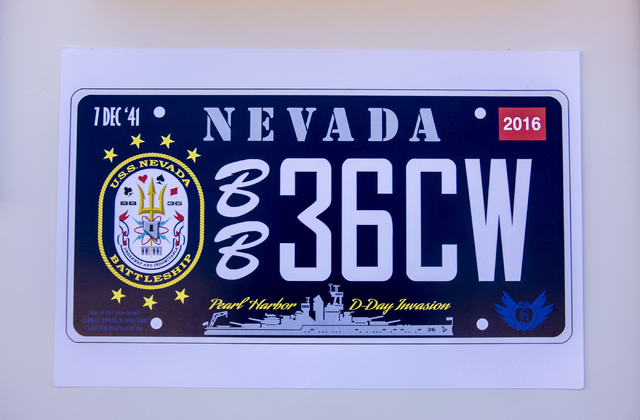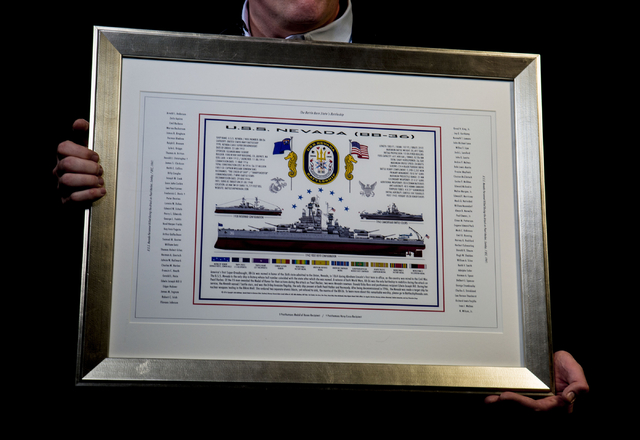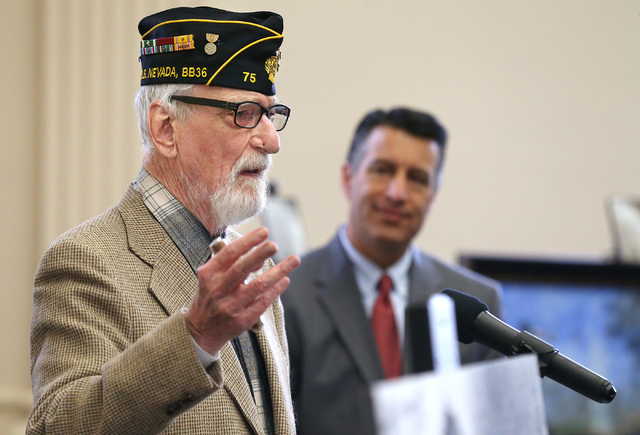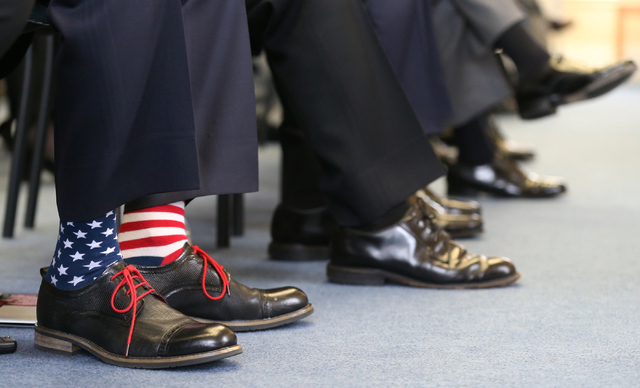Remembering the USS Nevada’s daring run for the sea during attack on Pearl Harbor
The USS Nevada was “defended by teenagers” when it was strafed, bombed and torpedoed during the Japanese attack on Pearl Harbor on Dec. 7, 1941. But the steel in the souls of those young men helped them pull off one of the most storied maneuvers in maritime military history.
The story of the Nevada’s improbable run for the sea 75 years ago on Wednesday – it was the only U.S. battleship that managed to get underway during the attack — is not only about the valor of her crew, however.
The state’s “Battle Born” namesake was herself a warrior for the ages: The World War I-vintage battleship not only survived the attack on Pearl Harbor, but went on to fire her guns during the D-Day invasion in France, in South Pacific battles at Iwo Jima and Okinawa and finally survive two nuclear bomb blasts off Bikini island before being mercifully dispatched to Davy Jones’ locker.
As the nation pauses this week to remember the sneak attack that forever changed America, two of the last USS Nevada sailors standing — Charles Sehe, 93, and “Woody” Woodrow Wilson Derby, “just a kid” at 98 — also will pay their respects to the Navy’s first “super-dreadnought.”
“It was really a tough, tough day, but we survived it,” Derby said Thursday from his home in San Diego.
He was 23 at the time, and Sehe, who lives in Mankato, Minnesota, was 18. The average age of their shipmates was 19½.
“When the attack came the ship was defended by teenagers,” Sehe recalled. “They went to their anti-aircraft guns and began firing.”
“It really wasn’t a typical teenage Sunday morning,” he added in what in other circumstances would be a comical understatement. “To me it’s been one rich, rewarding, challenging, enlightening experience, and I wouldn’t want to go through it again.”
Most of the U.S. Pacific Fleet was moored along Battleship Row that Sunday, when the first wave of Japanese bombers and Zero fighters appeared over Oahu, Hawaii, shortly before 8 a.m.
The Nevada along with the USS Arizona and USS Oklahoma had been at sea training for two weeks and had just returned to Pearl Harbor on Friday. Most of the senior officers were on weekend leave in Honolulu.
The ship’s band and Marine color guard were assembled on the fantail deck to raise the U.S. flag while most of the crew finished breakfast.
Sehe, a seaman second class from Geneva, Illinois, had just left the dining area to use the enlisted men’s head.
“The concusions of the first bombs … literally blew me from my seat,” he wrote in an account preserved in the U.S. Navy Museum. “Already incoming planes were strafing the exposed deck areas with machine gun bullets and the color guard and band members were scattering for safety.
“All I could do was watch this terrible, alarming, unbelievable nightmare unfold before my eyes.”
‘GOING TO GET YOU BASTARDS’
Sehe (pronounced SAY-hee) ran, then climbed to his battle station, a searchlight platform up the main mast.
“I could see the planes coming in, crisscrossing over the harbor. They had selected their targets. I just looked at it dumbfounded,” he said, adding that he spotted torpedo wakes streaming toward the West Virginia, the Oklahoma and the Nevada.
Derby, the ship’s chief storekeeper and disbursing clerk, was locking up the mail room when he heard the first explosions.
“I said, ‘That sounded like hell. We’re going to have people injured or killed.’ It was bad. We were holding our breath.”
Later, he said, he went to help hand 5-inch ammunition to the topside guns, all the while thinking, “We’re going to get you bastards.”
And they did. Nevada’s anti-aircraft guns knocked down two Japanese planes while moored. Once underway, it shot down two more as it steamed toward the harbor entrance.
Getting out of the sitting-duck array of battleships and into the harbor was itself precarious.
With Capt. Francis W. Scanland absent, Ensign Charles Jenkins was in command of the deck and Lt. Cmdr. Francis Thomas served as the acting skipper.
It took about 40 minutes for the oil-fired boilers to build up enough steam to move the massive ship after Chief Quartermaster Robert Sedberry, at 8:03, ordered the engine room to prepare to get underway, according to Las Vegas military historian Bill McWilliams, author of “Sunday in Hell,” a minute-by-minute account of the attack.
The heroic actions of two USS Nevada sailors during the chaotic dash for the sea resulted in Medal of Honor awards.
Chief Boatswain Edwin J. Hill led a 10-man line-handling detail in swimming to release the ship from its quays, then completing the “lap” to return to the ship. Then, after the ship had passed by the burning vessels on Battleship Row, harbor command signaled to halt, lest it be sunk and block the channel. Hill was attempting to drop anchor when he was blown overboard by bomb blasts and killed.
The other recipient, Machinist Donald K. Ross, by himself braved smoke, steam and heat in the damaged dynamo room to provide electricity for the ship “until blinded and unconscious.”
“Upon being rescued and resuscitated, he returned and secured the forward dynamo room and proceeded to the after dynamo room where he was later again rendered unconscious by exhaustion. Again recovering consciousness he returned to his station where he remained until directed to abandon it,” the citation reads.
ON WITH THE WAR
As the attack continued, Sehe shimmied down the main mast to help fight fires. The ship had lost electrical power “so there was no water to spray. We used blankets and mattresses, anything, but it didn’t help much.”
When the second wave of enemy aircraft arrived, bombers at first focused on the USS Pennsylvania in dry dock but when they saw the Nevada heading down the channel they saw an opportunity to sink it and make it impossible for other ships to enter or exit.
But Derby said they weren’t expecting the fierce fusillades that the Nevada crew directed their way.
“We started shooting and they went the other way,” he said. “It was really a noisy, noisy time. I think they thought we were doing a better job than them.”
The Nevada eventually ran aground off Hospital Point.
“We were wedged in a cane field,” Sehe said. “We tried to get all the wounded out as soon as possible.”
With a strong tide and winds whipping, the ship began to drift, its stern slowly swinging toward the harbor entrance like a closing gate. But with the help of tugs, Nevada’s commanders were able to back across the channel and reach the Waipio Peninsula about a half mile away, where the ship was beached and settled in shallow water.
John Galloway, a Las Vegas military history buff, marvels at the ship’s ability to absorb punishment and keep on fighting.
“She took a torpedo, 10 armor-piercing bombs and was still underway, on fire, taking on water,” he said.
Fifty sailors and seven Marines who were aboard her died during the attack.
Afterward, the Nevada underwent temporary repairs at Pearl Harbor and then a major overhaul at Puget Sound Navy Yard in Washington.
It returned to action in time for the Utah Beach landing during the D-Day invasion of Normandy on June 6, 1944, knocking out dozens of German Nazi tanks.
Sehe, who was still serving on the Nevada, remembers many near misses from big German guns, but no direct hits.
“That ship was straddled 27 times with rounds by German 15-inch guns. They hit on each side, back and forth. We saw some shells go right between the masts,” he said.
Nevada’s 14-inch guns were then refitted with some recovered from the sunken USS Arizona and USS Oklahoma before it sailed to the South Pacific to soften the Marine landings on Iwo Jima. The ship endured kamikaze attacks then and during the Battle of Okinawa that killed 11 sailors.
‘AMAZING SHIP’
The USS Nevada was built by the Fore River Shipbuilding Co. after Congress approved a $5.9 million contract in 1912, and launched at Quincy, Massachusetts, on July 11, 1914. Nevada Gov. Tasker Oddie’s niece, Eleanor Anne Siebert, broke a bottle of champagne on her bow and Assistant Secretary of the Navy Franklin D. Roosevelt, who would serve as president during World War II, attended the christening ceremony.
The first U.S. ship with triple gun turrets and an oil-fired steam power plant, she served briefly in World War I, escorting supply ships.
After her gallantry during World War II, it seems she should have met a better end.
Instead, she was painted red-orange and positioned in a fleet of target ships off Bikini atoll, where she endured an atmospheric nuclear bomb blast on June 30, 1946, and a second 21-kiloton underwater nuclear detonation on July 24 that same year. She didn’t sink.
Two years later, the contaminated ship was towed to deep water, 65 miles southwest of Oahu, and used for Navy gunfire practice. She remained afloat until a Grumman Avenger sunk her with an aerial torpedo on July 31, 1948, sending her 3 miles down to the ocean floor. She landed upright.
Given the Nevada’s performance, it is no surprise that the Navy resurrected the name. The USS Nevada that sails today as a ballistic missile submarine — a cornerstone of the U.S. nuclear deterrence — was commissioned in 1986 and is based in Bangor, Washington.
No matter her contributions to U.S. security, it’s hard to imagine they will ever rival those of her predecessor.
“She was an amazing ship,” said Galloway, the Las Vegas history buff. “The USS Nevada just embodies the American spirit.”
STATE PAYS TRIBUTE
The ship and her sailors will receive one more tribute this week, when a metal plaque inside a cherrywood box will be dedicated in Hawaii.
The plaque is accompanied by a handwritten letter from Nevada Gov. Brian Sandoval that reads:
“On behalf of the people of the great state of Nevada, we are ‘All for our country’ and ‘Battle Born.’ We offer our utmost respect and gratitude for your service to our country.”
Galloway, 53, will be at Hospital Point to dedicate the plaque he designed and manufactured.
The names of the ship’s dead will be read there, as they will simultaneously at memorials in Carson City; the Southern Nevada Veterans Memorial Cemetery in Boulder City; in Quincy, Massachusetts, where the ship was launched; and in Norfolk, Virginia, her home base during World War I.
Linda Miller of Henderson, chairwoman of commemorative events for the Nevada Daughters of the American Revolution, will lead a group of USS Nevada veterans and family members to Pearl Harbor events this week, in part to raise awareness about the ship.
“It’s an important story that has not been fully told,” she said.
Derby, one of the last USS Nevada survivors, has another take.
“Some things you should never forget but they just slide away,” he said. “The ones who were there will never forget.”
Contact Keith Rogers at krogers@reviewjournal.com or 702-383-0308. Find him on Twitter: @KeithRogers2.


























